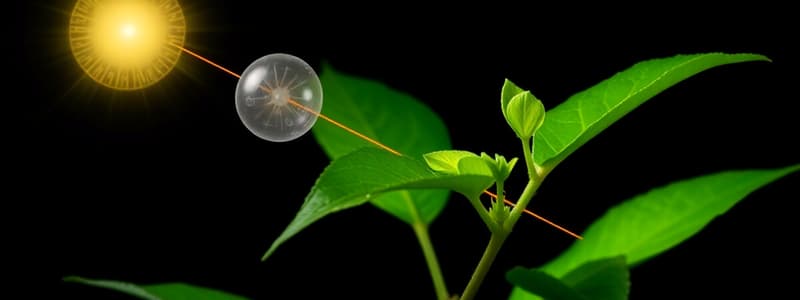Podcast
Questions and Answers
What does CamScanner primarily allow users to do?
What does CamScanner primarily allow users to do?
- Scan and digitize documents (correct)
- Edit videos and audio files
- Manage database operations
- Create presentations from images
Which feature is most commonly associated with CamScanner?
Which feature is most commonly associated with CamScanner?
- Cloud-based email management
- Video editing capabilities
- Real-time collaborative editing
- Optical character recognition (OCR) (correct)
In terms of document sharing, what is a typical functionality offered by CamScanner?
In terms of document sharing, what is a typical functionality offered by CamScanner?
- Password protection of shared files (correct)
- Integration with music storage services
- Direct file conversion to .exe format
- Automatic email generation for sharing
Which of the following statements best describes the output format options available in CamScanner?
Which of the following statements best describes the output format options available in CamScanner?
Which customer segment is most likely to benefit from using CamScanner?
Which customer segment is most likely to benefit from using CamScanner?
Flashcards
Photosynthesis location
Photosynthesis location
Photosynthesis happens in chloroplasts, specifically in the green parts of plants.
Light-dependent reactions
Light-dependent reactions
These reactions happen in the grana (thylakoids) and use light energy to split water and create ATP and NADPH.
Dark reactions
Dark reactions
These reactions happen in the stroma and use ATP and NADPH to make glucose (sugars) from CO2.
Chlorophyll a
Chlorophyll a
Signup and view all the flashcards
Chloroplast alignment
Chloroplast alignment
Signup and view all the flashcards
Study Notes
Photosynthesis Location and Processes
- Photosynthesis occurs in the green parts of plants, specifically in the chloroplasts.
- Chloroplasts exhibit a clear division of labor, with distinct regions:
- Grana (thylakoids): responsible for light-dependent reactions, trapping light energy.
- Stroma (stroma lamellae): site of light-independent (dark) reactions, where sugars are synthesized.
- Light-dependent reactions produce ATP and NADPH.
- Dark reactions utilize these products to fix CO2 (Carbon dioxide) and synthesize sugars (sugars are stored as starch).
Light Reactions (Photochemical Reactions)
- These reactions occur in the grana of chloroplasts.
- Light energy is absorbed and used to split water molecules (photolysis), releasing oxygen.
- ATP and NADPH are generated.
- This process is directly driven by light.
Dark Reactions (Carbon Reactions)
- The dark reactions occur in the stroma of the chloroplasts.
- These reactions utilize the products of light reactions (ATP and NADPH) and CO2 to create sugars.
- These reactions are not directly driven by light.
Chloroplast Pigments
- Chloroplasts contain various pigments, primarily chlorophyll a and b, carotenoids, and xanthophylls.
- These pigments absorb different wavelengths of light, with chlorophyll a being most important for photosynthesis (highest absorption in blue and red light).
- Different pigments absorb different colors of light and use that colour. The color of the pigment is due to the light it reflects (e.g., chlorophyll reflects green light, hence its green colour).
Alignment of Chloroplasts
- Chloroplasts align themselves within the mesophyll cells in response to light intensity.
- At high light intensity, chloroplasts align parallel to the light's direction.
- At low light intensity they form 90° angle to the light's direction.
- Chloroplast alignment optimizes their exposure to light.
Photosynthetic Pigments
- Photosynthesis pigments are special molecules that absorb light, enabling photosynthesis.
- Different colors of light have different wavelengths and pigments absorb specific wavelengths.
Chlorophyll Separation
- Leaf pigments can be separated using paper chromatography.
- This separation reveals multiple pigments, not one.
Absorption Spectrum
- The absorption spectrum displays the absorption of light at different wavelengths by a specific pigment.
- Chlorophyll a absorbs most strongly in the red and blue regions of the visible light spectrum.
Action Spectrum
- The action spectrum demonstrates the rate of photosynthesis at different wavelengths of light.
- The action spectrum closely parallels the absorption spectrum of chlorophyll a, indicating chlorophyll a's crucial role in photosynthesis.
Electron Transport Chain
- In photosynthesis, electron transport chains move electrons from water to NADP⁺.
- This process generates ATP.
- Electron transport occurs in the thylakoid membrane.
Differences in Reaction Sites
- Grana thylakoids perform light reactions.
- Stroma thylakoids are involved in the different types of phosphorylation
Types of Phosphorylation
- Cyclic and noncyclic photophosphorylation occur within the chloroplasts.
- Photophosphorylation is the process of ATP creation using light energy.
- Oxidative phosphorylation occurs in mitochondria.
Studying That Suits You
Use AI to generate personalized quizzes and flashcards to suit your learning preferences.




